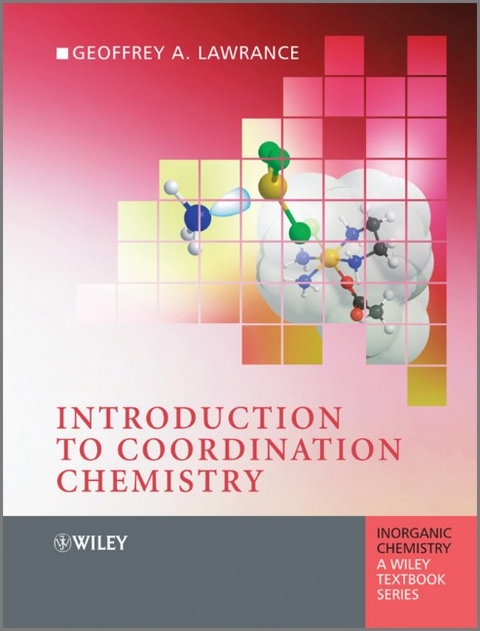
Introduction to Coordination Chemistry
John Wiley & Sons Inc (Verlag)
978-0-470-51930-1 (ISBN)
At the heart of coordination chemistry lies the coordinate bond, in its simplest sense arising from donation of a pair of electrons from a donor atom to an empty orbital on a central metalloid or metal. Metals overwhelmingly exist as their cations, but these are rarely met ‘naked’ – they are clothed in an array of other atoms, molecules or ions that involve coordinate covalent bonds (hence the name coordination compounds). These metal ion complexes are ubiquitous in nature, and are central to an array of natural and synthetic reactions. Written in a highly readable, descriptive and accessible style Introduction to Coordination Chemistry describes properties of coordination compounds such as colour, magnetism and reactivity as well as the logic in their assembly and nomenclature. It is illustrated with many examples of the importance of coordination chemistry in real life, and includes extensive references and a bibliography.
Introduction to Coordination Chemistry is a comprehensive and insightful discussion of one of the primary fields of study in Inorganic Chemistry for both undergraduate and non-specialist readers.
Professor Geoffrey Lawrance; Professor of Chemistry and Assistant Dean Research (Science & IT), The University of Newcastle, Australia Professor Lawrance is the author or co-author of over 290 journal articles, review articles and book chapters in a career spanning three decades. He has contributed chapters to Encyclopaedia of Inorganic Chemistry II (Wiley, 2005), and Comprehensive Coordination Chemistry II (Elsevier, 2004).
Preface. Preamble.
1 The Central Atom.
1.1 Key Concepts in Coordination Chemistry.
1.2 A Who’s Who of Metal Ions.
1.3 Metals in Molecules.
1.4 The Road Ahead.
Concept Keys.
Further Reading.
2 Ligands.
2.1 Membership: Being A Ligand.
2.2 Monodentate Ligands – The Simple Type.
2.3 Greed is Good – Polydentate Ligands.
2.4 Polynucleating Species – Molecular Bigamists.
2.5 A Separate Race — Organometallic Species.
Concept Keys.
Further Reading.
3 Complexes.
3.1 The Central Metal Ion.
3.2 Metal-Ligand Marriage.
3.3 Holding On — The Nature of Bonding in Metal Complexes.
3.4 Coupling – Polymetallic Complexes.
3.5 Making Choices.
3.6 Complexation Consequences.
Concept Keys.
Further Reading.
4 Shape.
4.1 Getting in Shape.
4.2 Forms of Complex Life.
4.3 Influencing Shape.
4.4 Isomerism – Real 3D Effects.
4.5 Sophisticated Shapes.
4.6 Defining Shape.
Concept Keys.
Further Reading.
5 Stability.
5.1 The Makings of a Stable Relationship.
5.2 Complexation – Will it Last?
5.3 Reactions.
Concept Keys.
Further Reading.
6 Synthesis.
6.1 Molecular Creation — Ways to Make Complexes.
6.2 Core Metal Chemistry — Periodic Table Influences.
6.3 Reactions Involving the Coordination Shell.
6.4 Reactions Involving the Metal Oxidation State.
6.5 Reactions Involving Coordinated.
6.6 Organometallic Synthesis.
Concept Keys.
Further Reading.
7 Properties.
7.1 Finding Ways to Make Complexes Talk — Investigative Methods.
7.2 Getting Physical — Methods and Outcomes.
7.3 Probing the Life of Complexes — Using Physical Methods.
Concept Keys.
Further Reading.
8 A Complex Life.
8.1 Life’s a Metal Ion.
8.2 Metalloproteins and Metalloenzymes.
8.3 Doing What Comes Unnaturally - Synthetic Biomolecules.
8.4 A Laboratory-free Approach — In Silico Prediction.
Concept Keys.
Further Reading.
9 Complexes and Commerce.
9.1 Kill or Cure? — Complexes as Drugs.
9.2 How Much? — Analysing with Complexes.
9.3 Profiting from Complexation.
9.4 Being Green.
9.5 Complex Futures.
Concept Keys.
Further Reading.
Appendix A Nomenclature.
Appendix B Molecular Symmetry: The Point Group.
Index.
| Erscheint lt. Verlag | 22.2.2010 |
|---|---|
| Reihe/Serie | Inorganic Chemistry: A Textbook Series |
| Verlagsort | New York |
| Sprache | englisch |
| Maße | 197 x 254 mm |
| Gewicht | 737 g |
| Themenwelt | Naturwissenschaften ► Chemie ► Anorganische Chemie |
| Naturwissenschaften ► Chemie ► Physikalische Chemie | |
| ISBN-10 | 0-470-51930-4 / 0470519304 |
| ISBN-13 | 978-0-470-51930-1 / 9780470519301 |
| Zustand | Neuware |
| Haben Sie eine Frage zum Produkt? |
aus dem Bereich


